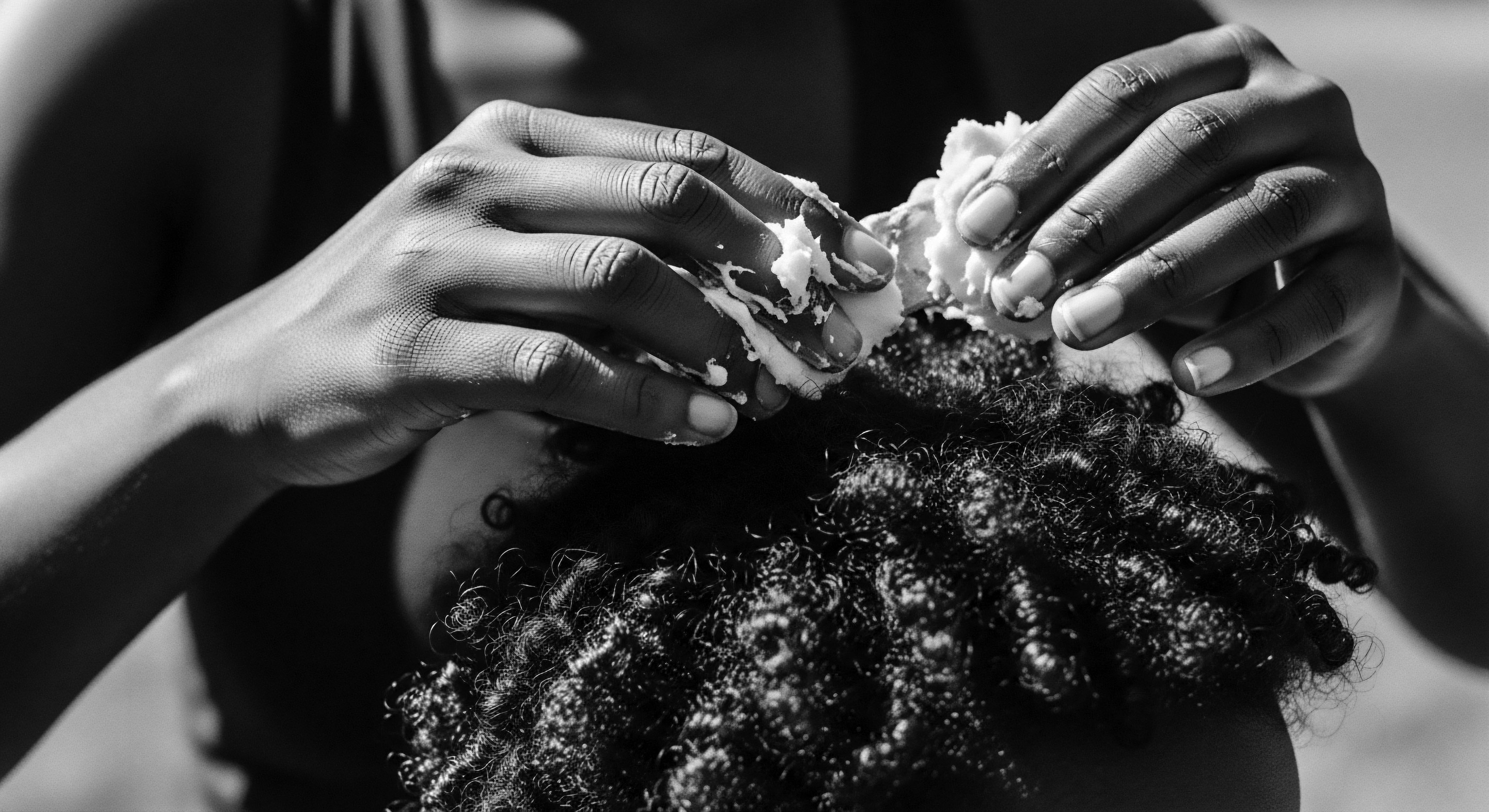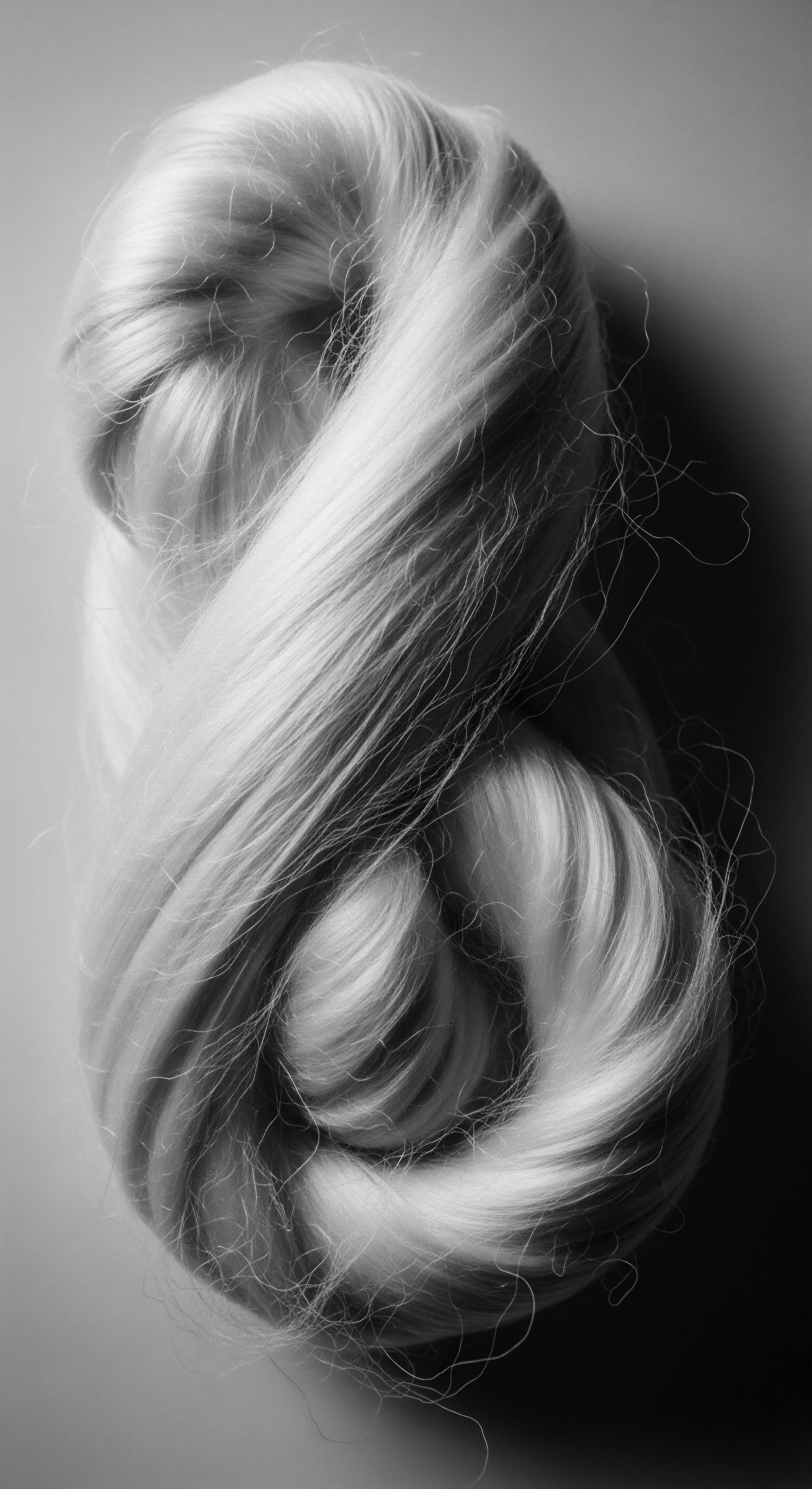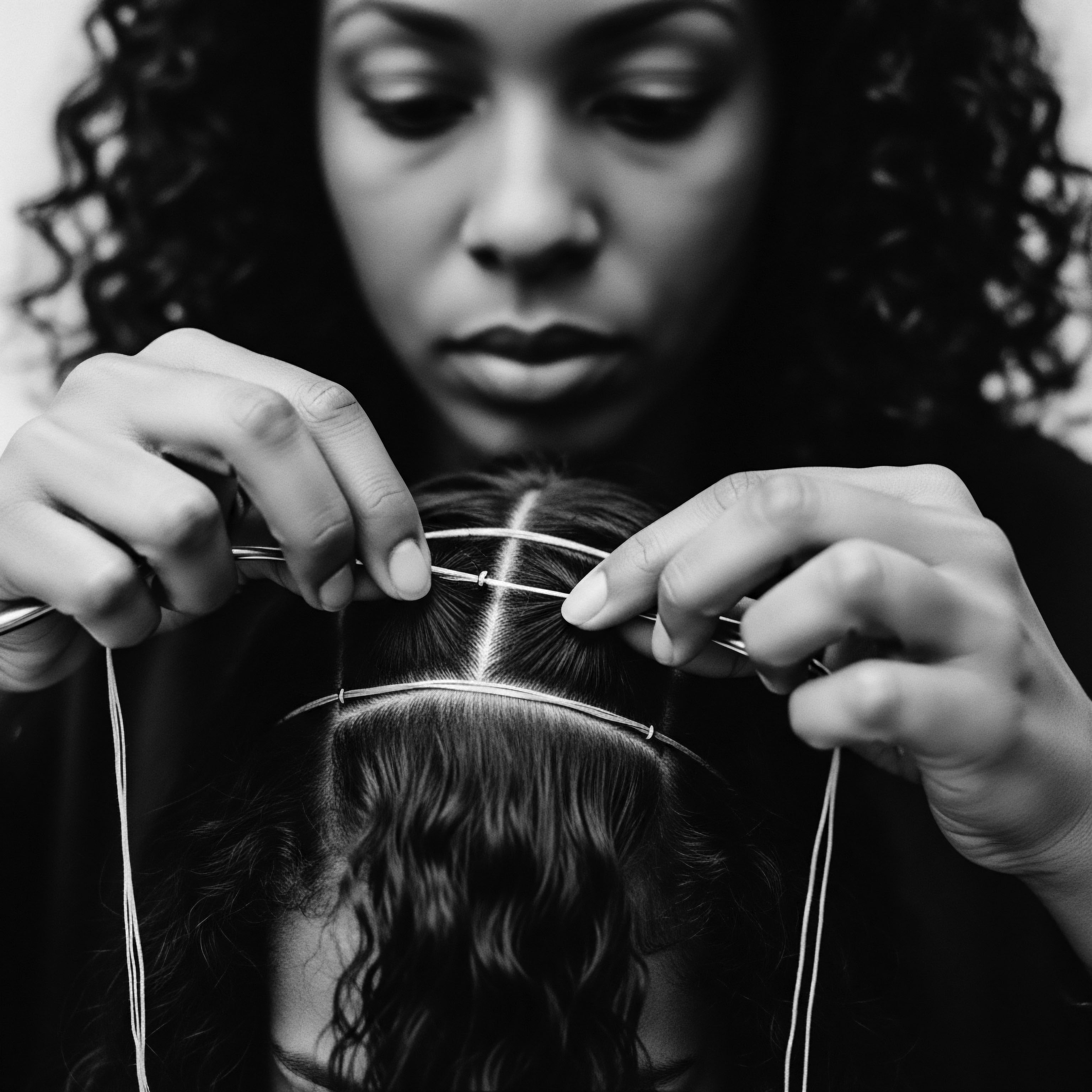
Fundamentals
The very notion of Hair PH Balance reaches into the elemental fabric of existence, a silent yet profound principle governing the vitality of textured strands. It speaks to the measure of acidity or alkalinity present within the hair shaft and scalp environment, a delicate equilibrium that dictates strength, resilience, and even how light dances upon each curl and coil. At its simplest, this balance is expressed on a scale from 0 to 14, with 7 signifying a neutral state. Values below 7 indicate increasing acidity, while those above 7 denote escalating alkalinity.
For the hair and scalp, a slightly acidic range, typically between 4.5 and 5.5, represents an optimal state, fostering a protective barrier known as the Acid Mantle. This natural shield, a thin, protective layer of sebum, sweat, and amino acids, safeguards the scalp from microbial intrusion and helps seal the hair cuticle, preserving moisture within the strand.
Understanding this fundamental explanation of Hair pH Balance is not merely an academic exercise; it is a rediscovery of principles that echo through generations of textured hair care. Long before scientific instruments could quantify pH, ancestral practices intuitively recognized the effects of various substances on hair. The careful selection of certain plants, clays, or water sources for cleansing and conditioning was, in essence, an application of this inherent wisdom.
The traditional use of fermented rinses, for instance, often introduced a gentle acidity, contributing to the very balance we now articulate with precise numbers. This inherent knowing, passed down through the hands of matriarchs and community elders, speaks to a profound connection between the earth’s offerings and the hair’s enduring well-being.
Hair pH Balance represents the vital measure of acidity or alkalinity that underpins the health and structural integrity of textured hair, a concept intuitively understood across ancestral care traditions.
Consider the daily rhythms of hair care in many traditional communities. Cleansing agents were often derived from natural sources, their properties intimately known through generations of observation. For example, certain saponin-rich plants, while appearing mild, might have offered a gentle cleansing action without excessively stripping the hair’s natural oils, thus preserving its delicate pH. The post-cleansing rinse, a crucial step in many rituals, often involved acidic ingredients like fruit vinegars or herbal infusions, designed to smooth the hair’s outer layer.
- Acid Mantle ❉ This protective layer on the scalp and hair maintains optimal pH, preventing moisture loss and deterring bacterial growth.
- Cuticle Health ❉ The outermost layer of the hair, the cuticle, lies flat in an acidic environment, leading to smoothness and shine; an alkaline environment causes it to swell and lift.
- Moisture Retention ❉ A balanced pH helps the cuticle remain closed, sealing in essential moisture and preventing dryness, a common challenge for textured hair.
The Meaning of Hair pH Balance, therefore, extends beyond a simple chemical reading. It embodies a legacy of careful stewardship, a recognition of hair as a living entity that responds to its environment. This foundational understanding becomes the lens through which we appreciate the ingenuity of our forebears, whose practices, though not termed “pH balancing,” served precisely this purpose, ensuring the vitality and beauty of textured strands through the ages. The preservation of hair’s inherent moisture and structural integrity was a cornerstone of these ancient care regimens, instinctively guided by the subtle responses of the hair itself.

Intermediate
Moving beyond the elemental definition, an intermediate exploration of Hair PH Balance unveils its deeper physiological and structural implications for textured hair. Each strand of hair, a marvel of biological engineering, possesses an intricate architecture that is profoundly influenced by its surrounding pH. The outermost layer, the Cuticle, comprises overlapping scales, akin to shingles on a roof.
In its ideal, slightly acidic state, these scales lie flat and smooth, creating a resilient, light-reflecting surface that locks in moisture and prevents tangling. This smooth alignment is a testament to the hair’s natural defensive mechanisms, allowing it to withstand environmental stressors and daily manipulation.
Conversely, exposure to substances with a higher, more alkaline pH causes the cuticle scales to lift and swell. This opening of the cuticle, while sometimes desired for processes like coloring or chemical treatments to allow penetration, leaves the hair vulnerable. It permits moisture to escape, leads to increased friction between strands, and makes the hair more susceptible to damage, breakage, and dullness.
For textured hair, which naturally possesses a more open cuticle structure and often experiences greater porosity, maintaining this delicate balance is not merely beneficial; it is a cornerstone of preserving its inherent strength and aesthetic vibrancy. The hair’s natural coils and kinks, while beautiful, present more surface area for the cuticle to lift, making the impact of pH imbalances even more pronounced.
The Significance of Hair pH Balance for textured hair finds expression in the historical evolution of hair care practices. Consider the prevalence of highly alkaline lye-based relaxers that dominated the market for decades. While these chemical processes effectively straightened hair by breaking disulfide bonds, their extreme alkalinity (often pH 12-14) caused significant cuticle damage, leading to dry, brittle, and weakened strands.
This historical context highlights the profound impact of pH on hair integrity and the challenges faced by generations seeking specific styles. The enduring wisdom of ancestral traditions, however, often presented gentler alternatives.
| Aspect of Care Cleansing Agents |
| Ancestral Practice (pH-Conscious) Saponin-rich plants like soapberry or aloe vera, offering mild cleansing. |
| Contemporary Scientific Understanding (pH-Validated) pH-balanced shampoos with surfactants that cleanse without stripping the acid mantle. |
| Aspect of Care Conditioning Rinses |
| Ancestral Practice (pH-Conscious) Fermented fruit rinses (e.g. rice water, apple cider vinegar) to smooth the cuticle. |
| Contemporary Scientific Understanding (pH-Validated) Acidic conditioners and leave-ins formulated to close the cuticle and detangle. |
| Aspect of Care Styling & Adornment |
| Ancestral Practice (pH-Conscious) Clay masks or specific herbal pastes for setting and strengthening. |
| Contemporary Scientific Understanding (pH-Validated) Styling products designed to maintain pH, often with humectants for moisture. |
| Aspect of Care Moisture Retention |
| Ancestral Practice (pH-Conscious) Natural oils and butters (e.g. shea butter, coconut oil) applied to seal moisture. |
| Contemporary Scientific Understanding (pH-Validated) Emollients and occlusives in products that reinforce the hair's natural lipid barrier. |
| Aspect of Care The continuum of care for textured hair reveals an ancestral intuition aligning with modern scientific insights into Hair pH Balance. |
The choice of water itself held great Import in historical hair care. Hard water, prevalent in many regions, contains high mineral content that can be alkaline, leaving a residue on hair and disrupting its pH. Communities with access to soft, naturally acidic water sources might have noticed a discernible difference in hair’s manageability and luster.
This environmental factor shaped local practices, guiding the selection of other ingredients to counteract undesirable effects. The development of hair care rituals was, in part, a sophisticated dance with the inherent properties of available resources.
Furthermore, the understanding of Hair pH Balance provides a lens through which to examine the resilience of textured hair through periods of profound cultural upheaval. During times when access to traditional ingredients was limited, or when dominant beauty standards promoted practices detrimental to natural hair, communities often adapted, finding new ways to maintain hair health, even if unknowingly challenging its pH equilibrium. This adaptability, a testament to enduring spirit, highlights the persistent human desire to care for and adorn hair, regardless of external pressures.
- Protein Integrity ❉ Hair proteins (keratin) are strongest and most stable at their isoelectric point, which for hair is around pH 3.67. While not the target pH for the scalp, understanding this helps explain why acidic rinses strengthen the hair shaft.
- Chemical Processes ❉ Relaxers, dyes, and perms drastically alter hair pH to achieve their effects, necessitating careful rebalancing to mitigate damage.
- Product Formulation ❉ Modern hair care products are meticulously formulated to fall within the optimal pH range for hair and scalp, ensuring gentle cleansing and effective conditioning.
The journey towards a deeper Comprehension of Hair pH Balance allows us to honor both ancestral wisdom and contemporary scientific advances. It permits us to appreciate how traditional practices, often guided by generations of observational knowledge, laid the groundwork for our current understanding of hair chemistry. The subtle shifts in texture, the loss of sheen, or the feeling of dryness were all indicators, interpreted through inherited wisdom, signaling a need to restore equilibrium.

Academic
The academic Definition of Hair pH Balance transcends a mere measurement, standing as a critical descriptor of the biophysical state of the hair fiber and its follicular environment. It denotes the logarithmic scale that quantifies the concentration of hydrogen ions (H+) within the aqueous solutions interacting with the hair and scalp, thereby dictating the electrical charge and structural conformation of keratin proteins, the primary constituents of hair. This intricate interplay directly influences the integrity of the Cuticle, the stability of the Cortex, and the viability of the scalp’s microbial ecosystem.
A balanced pH, specifically within the acidic range of 4.5 to 5.5, ensures the protonation of specific amino acid residues within the keratin structure, maintaining the cuticle’s tightly imbricated configuration and minimizing electrostatic repulsion between individual fibers. This optimal state is not merely cosmetic; it is a fundamental determinant of hair’s tensile strength, elasticity, and its capacity for moisture retention, particularly salient for the inherent structural characteristics of textured hair.
The Meaning of Hair pH Balance, viewed through an academic lens, becomes a lens for understanding the complex adaptive strategies developed within communities with rich textured hair heritage. One compelling historical example, illuminating the profound impact of pH on Black hair experiences, can be found in the traditional West African practices of using Black Soap, or Alata Samina in Ghana and Togo, and Ose Dudu in Nigeria. This indigenous cleanser, crafted from the ashes of plantain peels, cocoa pods, or shea tree bark, combined with oils like palm kernel or shea butter, possessed an inherently alkaline pH, often ranging from 8 to 10. While modern dermatological perspectives might initially view such alkalinity as potentially disruptive to the scalp’s acid mantle, the enduring use of black soap for generations reveals a sophisticated, culturally embedded understanding of its application and subsequent neutralization.
Academic inquiry into these practices reveals a multi-layered Elucidation of Hair pH Balance in historical context. The alkalinity of black soap, a product of the saponification process from plant ashes, served as an effective cleansing agent, capable of dissolving oils and lifting impurities from the scalp and hair. For hair that often accumulated natural oils, environmental dust, and traditional styling compounds, this robust cleansing action was vital. However, the wisdom did not cease with cleansing.
Post-cleansing rituals almost invariably involved the application of acidic rinses, such as infusions of hibiscus (zobo in West Africa), tamarind, or citrus fruit juices. These natural acids served to effectively lower the pH of the hair and scalp, thereby closing the lifted cuticles, restoring shine, and mitigating the potential for dryness and breakage induced by the alkaline wash. This ancestral practice demonstrates an intuitive, albeit unquantified, mastery of pH balancing principles.
The historical use of alkaline black soap in West African hair traditions, meticulously followed by acidic botanical rinses, provides a compelling academic case study of ancestral pH management.
A specific instance that brings this into sharper Focus is documented in the work of Dr. Henry Drewal, an art historian and ethnographer, who has extensively researched Yoruba art and culture. His observations, while not directly quantitative pH studies, describe the meticulous care given to hair and the use of specific plant materials for both cleansing and conditioning. The systematic nature of these rituals, involving a sequence of applications, points to an understanding of cause and effect that mirrors modern chemical principles.
For instance, the traditional use of the Dendropanax Arboreus leaf (known as “tree ivy” in some contexts) in certain African and Caribbean communities as a hair detangler and conditioner, when crushed and applied, releases compounds that likely possess a mildly acidic or neutral pH, complementing the post-alkaline wash. This demonstrates a deep Delineation of ingredient properties within ancestral pharmacopoeia.
The implications of this ancestral knowledge for contemporary understanding of Hair pH Balance are profound. It underscores that hair health, particularly for textured strands, is not solely dependent on a single product’s pH, but on the cumulative effect of an entire regimen. The traditional practice of using alkaline cleansers followed by acidic rinses highlights a sophisticated, sequential approach to pH management. This stands in contrast to a simplistic view that all alkaline exposure is inherently detrimental.
Instead, it suggests that controlled, intentional pH shifts, when balanced with subsequent corrective measures, can serve specific cleansing or treatment purposes without compromising long-term hair integrity. This provides a valuable Clarification of the nuanced relationship between chemical properties and hair health.
Furthermore, the academic lens permits an examination of the socio-cultural Connotation of hair practices in relation to pH. During periods of forced assimilation or cultural suppression, access to traditional ingredients and knowledge systems was often disrupted. The imposition of Western beauty standards, frequently promoting harsh chemical straighteners with extreme pH levels, inadvertently led to widespread hair damage within Black communities.
This historical context underscores how the manipulation of hair pH became intertwined with issues of identity, self-acceptance, and even economic exploitation. The re-emergence of the natural hair movement, therefore, is not merely a stylistic shift; it is a reclamation of ancestral wisdom regarding hair health and a conscious return to practices that honor the hair’s natural pH equilibrium.
The study of Hair pH Balance, from an academic vantage, also compels us to consider the microscopic changes within the hair fiber. When the cuticle is repeatedly opened by high pH products, the delicate Lipid Layer that binds the cuticle cells together is compromised. This lipid layer, primarily composed of 18-methyl eicosanoic acid (18-MEA), is crucial for maintaining the hair’s hydrophobicity and preventing water absorption and swelling.
Alkaline environments can irreversibly damage 18-MEA, leading to permanently raised cuticles, increased porosity, and a chronic inability to retain moisture. This scientific Explication reinforces the profound long-term consequences of consistent pH imbalance, particularly for textured hair, which relies heavily on its structural integrity to maintain its unique curl pattern and resist environmental stressors.
From an academic perspective, the Interpretation of Hair pH Balance extends to the future of product development and consumer education. It advocates for formulations that not only achieve desired cosmetic effects but also respect the hair’s natural physiology. This involves a deeper understanding of buffer systems in products, the interaction of various ingredients at different pH levels, and the long-term impact of product regimens on the hair’s protein and lipid structures.
The goal is to create products that work in harmony with the hair’s intrinsic properties, rather than against them, thereby honoring the hair’s natural resilience and beauty. This is a scientific validation of the holistic approach often found in ancestral wisdom.
In conclusion, the academic pursuit of Hair pH Balance offers a comprehensive Statement of its importance, bridging the chasm between ancient empirical knowledge and contemporary scientific rigor. It is a concept that resonates deeply with the heritage of textured hair, providing a scientific framework for understanding why certain ancestral practices endured and why their wisdom remains pertinent in our modern world. The careful manipulation of pH, whether through the ashes of plants or the precise chemistry of a laboratory, has always been, and continues to be, a cornerstone of nurturing the health and preserving the beauty of hair, particularly for those whose strands carry the rich legacy of coiled and kinky textures. The journey of Hair pH Balance, from ancient hearths to modern labs, is a testament to the enduring human desire to understand and care for the crowning glory.
- Protein Denaturation ❉ Extreme pH values (both high and low) can lead to the irreversible denaturation of keratin proteins, altering the hair’s structural integrity and strength.
- Scalp Microbiome ❉ The scalp’s slightly acidic pH supports a healthy microbiome, deterring the proliferation of pathogenic fungi and bacteria that can cause scalp conditions.
- Swelling and Shrinkage ❉ Hair fibers swell significantly in alkaline solutions and shrink in acidic ones; this swelling can lead to damage if excessive or repeated.
- Ionization State ❉ The pH influences the ionization state of amino acids in hair, affecting intermolecular bonds and overall fiber strength and flexibility.

Reflection on the Heritage of Hair PH Balance
The journey through the intricate world of Hair PH Balance, from its elemental principles to its profound academic implications, ultimately brings us back to the beating heart of Roothea’s ‘living library’ ❉ the enduring heritage of textured hair. This exploration is not merely a dissection of scientific data; it is a profound meditation on the legacy carried within each strand, a whispered narrative of ancestral wisdom and resilience. The ‘Soul of a Strand’ ethos reminds us that hair is not merely protein and pigment; it is a repository of history, a marker of identity, and a vibrant connection to generations past. The delicate balance of pH, then, becomes a metaphor for the equilibrium sought in life itself—a harmonious state where vitality thrives, and beauty is celebrated in its most authentic form.
Our forebears, through their intuitive understanding of nature’s offerings, laid the groundwork for what we now quantify with precise measurements. They observed, they experimented, and they passed down practices that, though perhaps lacking the scientific terminology of today, inherently respected the hair’s natural state. The selection of specific plant extracts, the timing of rinses, the very hands that applied these remedies—all were part of a holistic approach that nurtured not just the hair, but the spirit connected to it. This profound connection to the earth, to community, and to self, is the true inheritance of Hair pH Balance within textured hair traditions.
The journey of Hair pH Balance from ancestral wisdom to scientific validation underscores the profound, unbroken lineage of care for textured hair, revealing it as a living testament to heritage.
The ongoing pursuit of understanding Hair pH Balance within the context of Black and mixed-race hair experiences is a continuous act of honoring this heritage. It is about recognizing that the struggles and triumphs associated with textured hair care are deeply intertwined with historical narratives, cultural shifts, and the persistent quest for self-acceptance. By delving into the scientific underpinnings of what our ancestors knew instinctively, we do not diminish their wisdom; rather, we amplify its resonance, providing a contemporary framework for its continued application. This dialogue between past and present allows us to forge a future where textured hair is universally understood, celebrated, and cared for with the reverence it deserves.
The future of textured hair care, guided by a deep appreciation for Hair pH Balance, lies in this synthesis. It invites us to move beyond superficial trends and towards practices that are deeply nourishing, structurally sound, and culturally affirming. It encourages a return to intentionality, to a mindful engagement with our hair that echoes the sacred rituals of old.
Each carefully chosen product, each gentle touch, becomes a continuation of a tender thread stretching back through time, weaving together ancestral knowledge with modern insight. This unbroken lineage of care ensures that the unbound helix, the magnificent spiral of textured hair, continues to tell its powerful, beautiful story for generations to come.

References
- Drewal, H. J. (1988). African Artistry ❉ Technique and Aesthetics in Yoruba Sculpture. Emory University Museum of Art and Archaeology.
- Khumalo, N. P. & Gumedze, F. N. (2018). The Science of Black Hair ❉ A Comprehensive Guide to Textured Hair Care. The Natural Hair Academy.
- Robbins, C. R. (2012). Chemical and Physical Behavior of Human Hair. Springer.
- Dawber, R. P. R. & De Berker, D. (2007). Diseases of the Hair and Scalp. Blackwell Publishing.
- Draelos, Z. D. (2011). Cosmetic Dermatology ❉ Products and Procedures. Wiley-Blackwell.
- Ghasemi, M. Gholamzadeh, S. & Malekzadeh, R. (2017). Herbal Medicine in Hair Care ❉ Traditional Uses and Modern Approaches. Nova Science Publishers.
- Mboumba, J. (2010). The Ethnobotany of African Hair Care. University of Yaoundé Press.
- Poucher, W. A. (1993). Poucher’s Perfumes, Cosmetics and Soaps. Chapman & Hall.
